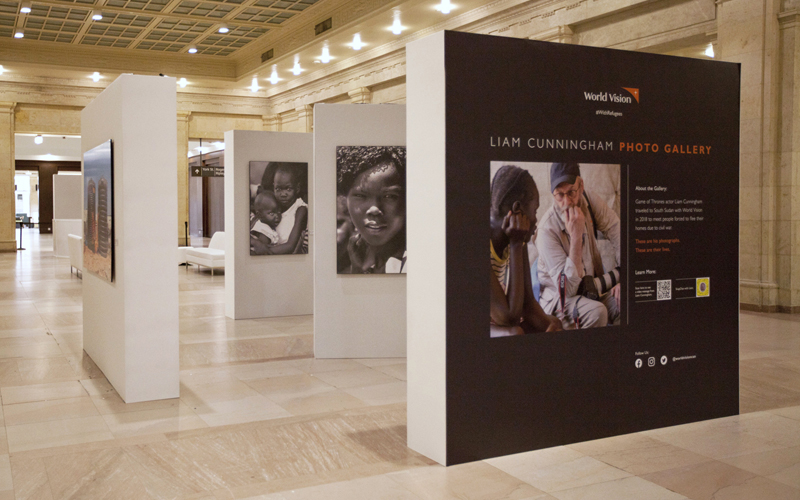70,800,000 is a big number. It’s so big, it can start to lose meaning. For example, in June 2018, Mars was
a mere 70.8 million kilometres away from Earth. Apparently, that’s close.
The UN says 70.8 million people were forced from their homes due to conflict violence, or human rights violations by the end of 2018.
That’s almost double the entire population of Canada. And it’s about 25 people every minute.
It’s such a massive number of people that it often feels overwhelming.
 A panorama view of Cox’s Bazaar in Bangladesh. With more than 1 million residents, it is the world’s largest refugee camp. Photo by Jon Warren
The power of stories
A panorama view of Cox’s Bazaar in Bangladesh. With more than 1 million residents, it is the world’s largest refugee camp. Photo by Jon Warren
The power of stories
June 20th was
World Refugee Day and it had me thinking about how to humanize something that can seem so abstract and so devastating.
And it turns out it’s pretty simple: stories.
Research shows stories activate our minds in ways that mere facts cannot, engaging our imagination, and the emotion centres of our brains so that we can grasp experiences we’ve never had before.
Story is what we need to help us get a sense of the experiences of those 70.8 million refugees. And if we share those stories, maybe they will trigger in us compassion for people we may never meet, in dire situations we may never find ourselves in.
This year, World Vision marked the day with an installation at Toronto’s historic Union Station called “
Untold: Behind the Headlines” to honour the courage of vulnerable displaced children and to share their stories.

Part of the installation at Toronto's Union Station marking World Refugee Day. Photo: Alison Ralph
From actor to advocate
From June 18 - 20, between 7am-7pm, the train station’s 300,000 daily visitors had the chance to view a gallery of never-before-seen photographs by Game of Thrones actor Liam Cunningham, who travelled to South Sudan with World Vision in 2018.
In a recent interview with the Toronto Star, Cunningham said, “We see so much in the media …we hear that millions of people have been displaced, millions of refugees. It’s very difficult to humanize that, which is part of the focus of the photographic exhibit that I’m doing.”
The gallery featured stunning black and white images of real people– women and children who are surviving civil war, drought, severe food shortages, and more, against the odds.
 A gallery of photographs by Game of Thrones actor Liam Cunningham at Union Station in Toronto for World Refugee Day. Photo: Alison Ralph
A gallery of photographs by Game of Thrones actor Liam Cunningham at Union Station in Toronto for World Refugee Day. Photo: Alison Ralph
The gallery came with an interactive component. Visitors had access to a SnapChat filter for a “selfie with Liam”, and could use a QR code to view a video of Liam in the field, seeing the work of World Vision first hand, and watching him capturing images of resilience in the faces of women and children he met there.
On the other end of the exhibit, visitors could look “behind” negative news headlines using augmented reality and virtual reality technology to see the real and raw stories of courageous children.
 Three young women watch a video on an ipad activated by augmented reality technology at an event at Toronto’s Union Station for World Refugee Day. Photo: Marie Cook
Three young women watch a video on an ipad activated by augmented reality technology at an event at Toronto’s Union Station for World Refugee Day. Photo: Marie Cook
A newspaper broadsheet featured typical news headlines about violence and conflict that we have become so desensitized to. With the help of augmented reality technology, participants could hold a tablet over the newspaper’s images and watch a video with little known stories of displaced children overcoming tremendous obstacles – children like ten-year-old Raja who was badly injured by a bomb during the battle for Mosul, Iraq. She lost her left hand and is unable to walk without assistance. Yet she’s overcoming the physical and emotional scars of war with a courage and resilience that I've never had to summon.
Guests used VR goggles to immerse themselves in a child-friendly-space, meeting children whose lives have been upended and displaced by conflict, violence and epic natural disasters. These spaces give kids the opportunity to remember what being a child is about, free from the fear and uncertainty that life has brought them.
These stories remind me that those 70.8 million refugees are human beings, not that different from me and my family and friends. They experience pain and suffering, joy and hope. And they deserve to live lives free from fear and exploitation, in safety and peace.
If you and I let ourselves dive into these stories, if we allow our hearts to be moved by the lives of children in crisis, just maybe we can move from overwhelmed and numb, to galvanized for action.